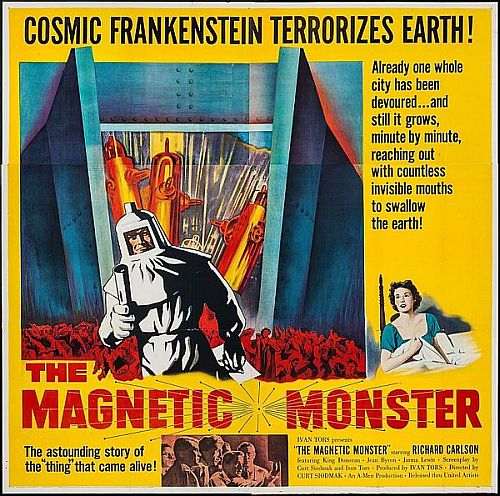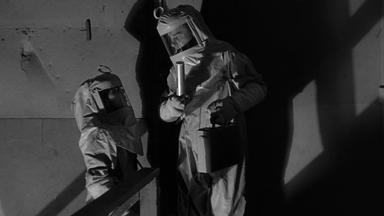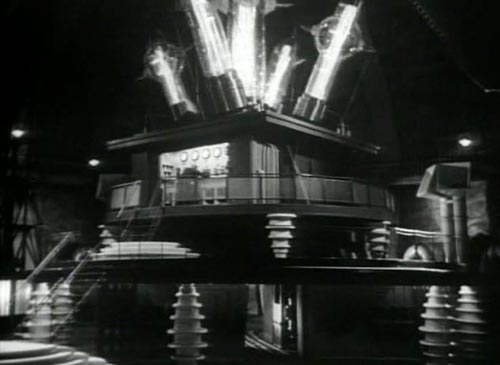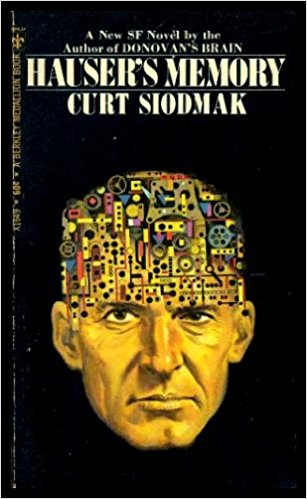IMDB metadata: 1 hour and 17 minutes at 5.9/10 from 817
The Cold War was never hotter than in 1953 with the see-saw Korean War piling up a body count of GIs. Was this but prelude to World War III? A lot of pundits at the time said so every day. Some wanted it to happen, believe it or not. This was the atmosphere in which audiences first saw this movie.
 The lobby card implies a creature, one that came alive.
The lobby card implies a creature, one that came alive.
Richard Carlson, ever reliable in B movieland, is sent to investigate strange occurrences at a local store. Voiceovers by Carlson with date and time noted, give it a documentary tone throughout.
Everything in the store is magnetised. Clocks and watches stop. Washing machine doors open and close. Loose change flies up to and adheres on the ceiling. Carlson stokes his chin and decides to go upstairs.
But wait! He and his bespectacled offsider, King Donovan, don radiation suits to do so because the click-click of the Geiger counter is excited. This is noteworthy.

The official line of the Atomic Energy Commission at the time was that radiation was a nuisance. Wash your hands, wear a coat, take an aspirin, and there will be no problem. For an example of this treatment of radiation see ‘The Atomic Man’ (1955), reviewed elsewhere on this blog. In 1953 fears of radiation were denounced by red blooded idiots as Commie fake news to weaken popular support for the development of Made in the USA nukes. There were those who denied the lethal but unseen effects of radiation.
Carlson finds upstairs that an emeritus professor, never to be trusted those types, has created a new element that combines nuclear radiation and magnetism! They also find Igor, dead. Both the element and the prof are gone, though the lingering aftereffects of the element remain virulent. Kind of like after a Twit in Chief speech, a deadly miasma remains.
The police, army, and girl scouts are called into the crisis, says the Carlson in a documentary voiceover. All are shown to be responsive and responsible. Ha! Well it is a work of fiction, so there are no petty bureaucrats obstructing things, no police officer dedicated to coffee drinking, and no soldiers hiding in the motor pool for a smoke. No girl scouts short a cookie or two.
They follow the invisible spoor of the prof’s radiation with Geiger counters aclicking to reassure the public. Big Brain that he is, prof has packed the deadly element in his tattered briefcase with his lunch and taken plane to Washington on the DC to prove to the world that he is no useless emeritus, but a genius. The element disables the airplane and it also kills him. Two dead. More follow.
Again radiation suits proliferate and great care is manifested in taking possession of the deadly element, so unlike most 1950s presentations of uranium, let’s call it that to keep it simple. No one rips off the hazard suit mask for close-ups, as we saw in ‘Arrival’ (2016).
Carlson and company peer through a microfilm reader at lights projected on the wall through the bottom of a Coca-Cola bottle in cutting edge science. The element which is here christened Carlsonium absorbs energy in great gulps and doubles in size every twelve hours. The fraternity brothers are a lot like that: Ingest everything and grow ever larger, but they are peaceable. Not so Carlsonium which sucks and sucks. It sucks!
The bigger it gets, the more it sucks in energy. Not even AAA batteries are safe from it. Lead-lined rooms cannot contain it. More deaths occur.
After thirty minutes of this, Carlson, who must have had a dog, decides to see just how much energy it can eat. He will pump so much energy into it that the resultant indigestion will kill it. Is this a plan or what?
Fortunately he knows just the place to stage this food-orgy (fraternity brothers, that is, ‘food orgy’), Nova Scotia. For generations people have wondered what Nova Scotia was good for and now they know! How quickly people forget, because the Nova Scotia Tourist Commission no longer mentions this event among its claims to fame.
Thanks to some quick typewriting in the screen play, they devise a way to transport the Carlsonium to Nova Scotia. Once there everyone dresses for a 1930s German expressionist film in broad brimmed fedoras and ankle length, tent overcoats. There they find yet another scientist pursing the KPIs of his life in a vast machine that can zap 600,000 watts of electricity at a time. Think of all those light bulbs.
 Nova Scotia, Light, and Power
Nova Scotia, Light, and Power
He welcome Carlson as a fellow scientist only to recoil at the plan to blow up the ever enlarging Carlsonium along with his gargantuan machine. Americans only go to Canada when they want something, he thought to himself, but this is too much.
This machine is served by a horde of workers dressed in ‘Metropolis’ (1926) fashions. At one point Carlson puts on a flat soft cap to fit in and then takes it off.
This is the only discord in the film. Fisticuffs result. Guess who prevails. Ka-boom. End.
This third act is mostly cut from an earlier German film, ‘Gold’ (1934). and inserted into this story line. Knowing that to be the case, one can easily see it, though for a naive viewer it might slip by with the pace of the story, which is lively. Robin Bales, always quick to slice and dice a film, when he reviewed this one made no mention of this insertion.
The director and writer was Curt Siodmak.

This was the first of producer Ivan Tors’s three films featuring the labours of the Office of Scientific Investigations whose agents, like Carlson in this instance, were styled A-Men, the ‘A’ being for Atomic.
The titular reference to a ‘Magnetic Monster’ puts in the phylum of creature features, but, in fact, there is no creature to this feature. Just a lump of coal. It is inert. Even less energetic than the fungus of ‘Space Master X-7’ (1958), reviewed elsewhere on this blog. The story of this latter film is similar in the pursuit of a carrier of a dangerous element. Though the film at hand has more lively direction, makes some effort at science, and has a more engaging lead than ‘Space Master X-7.’
Skip to content
